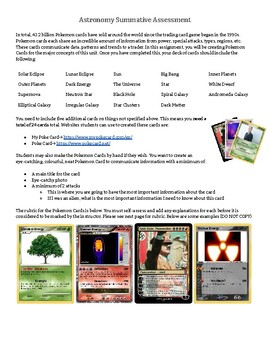Astronomy "Pokemon Card" Summative Assessment
- PDF
Description
High school astronomy is a branch of science that explores the celestial objects and phenomena beyond Earth's atmosphere. It delves into the vast expanse of the universe, studying the stars, planets, galaxies, and other cosmic entities, as well as the fundamental principles governing their existence and interactions. Here's a detailed description:
1. Observational Astronomy: High school astronomy often begins with observational techniques, teaching students how to use telescopes and other instruments to observe celestial objects. They learn about the motions of stars and planets across the night sky and how to identify constellations and other celestial landmarks.
2. Solar System Dynamics: Students study the structure and dynamics of our solar system, including the Sun, planets, moons, asteroids, comets, and other minor bodies. They learn about the formation of the solar system, planetary orbits, phases of the Moon, and the processes that shape planetary surfaces.
3. Stellar Astronomy: High school students explore the life cycle of stars, from their formation in stellar nurseries to their evolution into various stages such as red giants, white dwarfs, and supernovae. They learn about the classification of stars based on their spectra, luminosity, and temperature, as well as the factors that influence a star's brightness and color.
4. Galaxies and Cosmology: Students delve into the study of galaxies, including our own Milky Way galaxy and others beyond it. They learn about the different types of galaxies, such as spiral, elliptical, and irregular, and the structure of the universe on the largest scales. Concepts like dark matter, dark energy, and the expanding universe are also introduced.
5. Exoplanets and Astrobiology: With the discovery of thousands of exoplanets orbiting distant stars, high school astronomy now includes the search for habitable worlds and the possibility of extraterrestrial life. Students explore the conditions necessary for life to exist elsewhere in the universe and discuss the methods used to detect exoplanets and analyze their atmospheres.
6. Space Exploration: High school astronomy often covers the history and future of space exploration, including missions to explore our solar system and beyond. Students learn about key milestones in space exploration, such as the Apollo moon landings, the Voyager missions, and the exploration of Mars and other planets.
7. Interdisciplinary Connections: Astronomy intersects with various other scientific disciplines, including physics, chemistry, mathematics, and earth science. High school astronomy curriculum often integrates these subjects, helping students develop a holistic understanding of the universe and its underlying principles.



